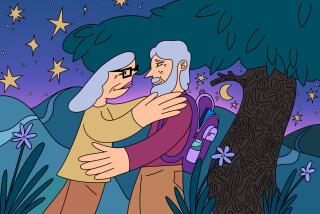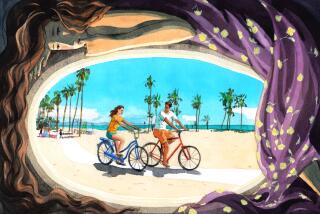Newly Discovered Jefferson Letters Hint of Loneliness and Love
- Share via
CHARLOTTESVILLE, Va. — She was beautiful and independent, with a razor-sharp intellect. Her patrician upbringing was tempered by sensitivity and tenderness.
Add exquisite taste and a fashionably understated style of dress, and she became a thief of hearts, a woman simply irresistible to a lonely widower in a foreign land, a man destined to become the third president of the United States.
“The morning you left us, all was wrong, even the sunshine was provoking, with which I never quarelled before,” he wrote her. “I took it into my head he shone only to throw light on our loss: to present a cheerfulness not at all in unison with my mind. I mounted my horse earlier than common. I took by instinct the road you had taken.”
It was Paris, the winter of 1788, and Thomas Jefferson, the author of the Declaration of Independence and now the U.S. ambassador to France, was smitten with the formidable Angelica Schuyler Church, the already married daughter of a Revolutionary War hero.
“I think I have discovered a method of preventing this dejection of mind on any future parting,” he wrote her on Feb. 17, the same day she left Paris to return to London.
“It is this,” he explained. “When you come again I will employ myself solely in finding or fancying that you have some faults. & I will draw a veil over all your good qualities, if I can find one large enough.”
(The spellings and punctuation in Jefferson’s letters are as they appeared in the original.)
Angelica Church likely came closest to meeting Jefferson’s feminine ideal after his beloved wife, Martha Wayles Jefferson, died in 1782, when he was only 39, said Jefferson scholar William Howard Adams.
“They were quite simpatico,” Adams said in an interview.
Adams devotes a chapter to Jefferson’s female friends in “The Paris Years of Thomas Jefferson” to be published in the spring of 1997 by Yale University Press. He gave Associated Press an advance look at the chapter titled, “The Women in His Life.”
New insights into Jefferson’s relationship with Angelica come from Jefferson letters recently purchased by the University of Virginia, the school he founded.
Angelica, sister-in-law of Jefferson’s bitter personal enemy, Alexander Hamilton, corresponded with many of the young country’s most prominent figures, among them Hamilton, George Washington and the Marquis de Lafayette. Her family kept the letters she received, but in February contacted a book dealer in Hadley, Mass., about selling them.
The dealer offered them first to the University of Virginia, which paid $275,000 for a total of 13 letters from Jefferson and 64 more from Hamilton, Washington, Lafayette and some lesser lights.
Angelica, 13 years younger than the tall red-haired Virginian, filled a real emotional need for Jefferson, says Adams, a fellow at the International Center for Jefferson Studies in Charlottesville.
A New Yorker, she replaced the beautiful and temperamental English artist Maria Cosway as the object of Jefferson’s affections while he was ambassador to France, Adams says.
Ironically, Angelica and Maria were friends and had conversations about Jefferson, he says.
At one point, Angelica gave Jefferson a handsome silver tea urn, “a perfect beauty,” according to the recipient. Angelica said she hoped the urn “will sometime at Monticello remind you of your friend.”
A small portrait of Jefferson by painter John Trumbull enthralled both women, and each obtained copies from the artist.
Angelica’s note accompanying the tea urn said that although Maria’s copy was better, she held a better likeness of Jefferson in her heart.
Was Jefferson in love with either of the women, both of whom were married?
“There is something going on, some sort of attraction” between Jefferson and Angelica, says Jan Lewis, professor of history at Rutgers University and author of “The Pursuit of Happiness: Family and Values in Jefferson’s Virginia.”
Lewis, however, believes that Jefferson was “head over heels in love” with Maria, not Angelica.
“He was deeply depressed” for years after his wife’s death. “Once he got to France, he pulled out of it,” she says, primarily because of Maria.
Still, Jefferson’s ardor for Angelica remained undiminished for many years after their first meeting in Paris in the winter of 1787. At the time, his infatuation with the flashier but more demanding and complex Maria was waning, and they eventually lost touch.
Six months after they met, Jefferson begs Angelica to return to Paris and in August 1788 he seductively proposes that she accompany him on a vacation to America.
“Think of it, my friend, and let us begin a negotiation on the subject. You shall find in me all the spirit of accommodation with which Yoric began his with the fair Piedmontese.”
The characters Jefferson mentioned are in a sexually charged scene in “Sentimental Journey,” a best-selling novel of the day by English writer Laurence Sterne. Yoric is forced to share a room at a crowded Italian country inn with the lovely stranger Piedmontese, and the two eventually have sex.
“The unexpected allusion in Jefferson’s letter remains ambiguous, his intentions disguised but hinting at other possibilities,” Adams says in his book.
In an earlier letter, Jefferson also urged Angelica to return with him to America: “Let’s go back together then. you intend it a visit; so do I. While you are indulging with your friends on the Hudson, I will go to see if Monticello remains in the same place, or I will attend you to the falls of Niagara, if you will go with me to the passage of the Potowmac, the Natural Bridge, etc.,” he wrote.
Said Lewis: “If you were a guy trying to make an impression on a woman [in the late 18th century] you would take her to Niagara Falls or Natural Bridge.”
A decade later, Jefferson was still trying. Writing from Philadelphia after Angelica arrived in New York, the vice president of the United States pines: “Tho you have taken so great a step, there is still a wide space between us. I shall entertain the hope that we may meet at this place, as on a middle ground. perhaps you may find it not unpleasant in winter to get this much nearer the sun. but whether we meet or not, I shall for ever claim an esteem which continues to be very precious to me, and hope to be, at times, indulged with the mutual expression of it.”
Adams says it is impossible to know for certain if Jefferson ever had a love affair with Angelica, Maria Cosway, or other women, including Sally Hemings, a slave at Monticello rumored to have had a long-term sexual relationship with her master.
According to a story told by slaves, Jefferson swore to his dying wife that he would never remarry, and he didn’t.
But Lewis said, “It seems implausible that a man who enjoyed marriage so much would have become a celibate widower.”
More to Read
Sign up for our Book Club newsletter
Get the latest news, events and more from the Los Angeles Times Book Club, and help us get L.A. reading and talking.
You may occasionally receive promotional content from the Los Angeles Times.










